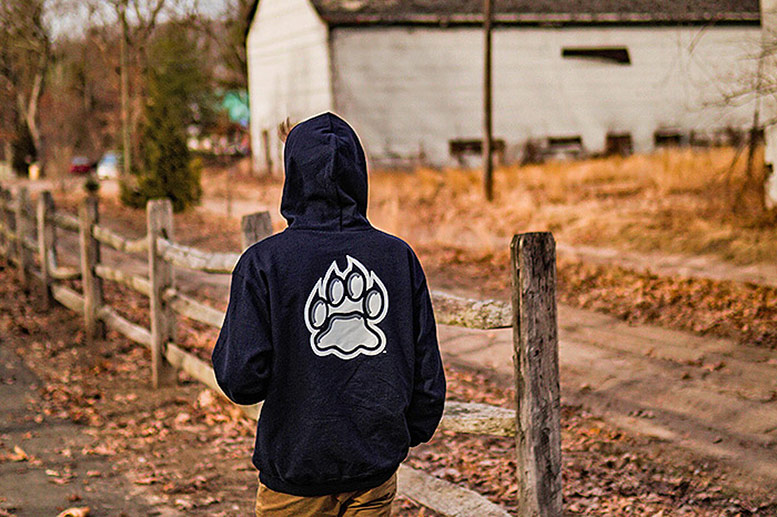
The Evolution of the Hoodie
One of the most popular items of clothing that are worn all over the world and come in different styles and sizes is the hooded sweatshirt, also known as the hoodie. The beauty and popularity of the hoodie are due to its function as a “moving” canvas, hoodies generally either have a brand logo on the front, an image (perhaps some artwork), or even a quote. This allows people of all ages to express themselves, although hoodies are primarily often worn by, and associated with the youth generation and those who love to wear athleisure clothing.
A hoodie is more than just an item of clothing, it is a piece of artwork that can be worn to express oneself. You could put ten hoodies of the same make together, each with different designs and you have ten individual and distinctive pieces of artwork.
But how did this very popular garment earn its fame? What does the hoodie represent in the modern world? Although being very comfortable and used for its great functionality as a sports garment, hoodies represent more than just an item of clothing worn for when going for a jog, hoodies represent a lifestyle.
Hoodies Throughout History

The first known hooded garments date back to the medieval era of history; hooded tunics known as cowls were worn by monks and a hooded cape known as a chaperon was worn by outdoor workers. Capes with hoods were quite popular in medieval Europe and the stereotypical portrayal of peasants and thieves in Europe at the time often depicted them wearing hooded garments.
An interesting point to note is that the words “hood” and “hat” derive from the Anglo-Saxon word “höd”.
The Modern Hoodie

The first modern hoodie (the term hoodie gained popularity during the 1990s) or hooded sweatshirt was made in the 1930s by the brand Champion which was established in the USA. The initial purpose of hooded sweatshirts was to keep workers warm, and the first to wear them were workers in upstate New York where the winter temperatures were extremely cold, but eventually, they began to be manufactured for sports purposes; hooded sweatshirts were also supplied to the US military for training purposes.
The Hoodie Enters the Fashion Scene

The rise of Hip-hop culture in 1970s New York paved the way for hoodies to enter people's wardrobes, and for the first time, purely as a garment intended to be worn for fashion. The hoodie really became popular following the release of the blockbuster film Rocky (1976) and it was also during the 70s that American universities began to produce hoodies with their logo emblazoned on the front, developing a sort of team spirit (even now, hoodies with matching logos, worn by charities, for example, create a sense that each individual wearing it is part of something bigger).
One Hoodie, Two Cultures

With the hoodies gaining popularity in the 1970s, the 1990s saw the rise of two separate youth cultures in two different countries which were both associated with the hoodie. In the USA aside from being intertwined with Hip hop culture, the 90s also saw the birth of the skateboarder culture; youths performing seemingly impossible tricks on skateboards sporting a colourful hoodie while they were at it.
In striking contrast to this, the United Kingdom had a unique youth culture evolve involving the hoodie; “chavs” (or “scallies” as they say in Liverpool) were stereotypically young, lower-class, anti-social men who lived in rough areas, and yes you guessed it, wore hoodies.
The difference between the hoodies that British lads wore and American skateboarders wore was the design. Whilst the Brits preferred to wear sports hoodies from brands like Nike and Adidas, skateboarders wore more colourful hoodies often from brands that had more of a cult following like Champion and Supreme, the latter becoming very popular over the past few years.
Unlike the "chav" culture, however, the skateboarder culture has been picked up all over the world and now nearly every country has its youth skateboarder culture.
The Victoria & Albert Museum has a diamond-studded hoodie designed by the rapper “Puff Daddy” on display.
Challenging the Hoodie Stereotype

The hoodie itself is just a stylish item of clothing but due to the actions of some who wear them, it has been associated with crime and concealing one's identity. In the UK hoodies are often worn by shoplifters who draw the hood over the face to hide from CCTV and also by a whole variety of hooligans and scoundrels.
Some people think that the solution to this problem is to ban hoodies in public places altogether, but this is not practical and ideal; hoodies are very comfortable items of clothing and are also great sportswear. Others try to show that hoodies can be worn by anyone in an attempt to dissociate them from crime; New Zealand had a “Goodie in a Hoodie” day in 2009 and the previous year many New Zealand politicians wore hoodies to show the harmlessness of it.
Many places in the UK, like shopping centres or clubs, have banned wearing a hoodie due to the security risk it poses. This is acceptable and is a reasonable rule for the public to adhere to but the idea of banning hoodies completely is absurd; how many times has it started to rain and you have been on a bike ride, obviously without an umbrella, with nothing but a hoodie to shelter you from the rain?
The Appeal of Hoodies

Regardless of what many people think of young people wearing hoodies and “loitering about on the street”, hoodies remain an inexpensive and fantastic way for people of all ages to express themselves and their personal preferences whether it be a hoodie with a band name on the front or even a video game logo, whilst keeping warm at the same time.
Although the hoodie became popular through Hip-hop culture in the USA, it has long since moved on to a much broader spectrum, video gamer hoodies and many other designs such as anime characters are associated with geeks and computer lovers, taking the spotlight away from what many people falsely believe the hoodie to be associated with.
All in all, hoodies can be used for a wide range of things from sports activities or simply even for casual wear. Hoodies are more than just a piece of clothing, they are canvases to be used for anything you want; a wearable work of art.









